|
< Earlier Kibitzing · PAGE 1 OF 2 ·
Later Kibitzing> |
| Nov-30-07 | | laskerdog: Rubby played a couple of strong moves. I particulary liked the 22nd Rxf7 and the silent killer 35.d7 |
|
| Feb-10-09 | | notyetagm: 22 ?
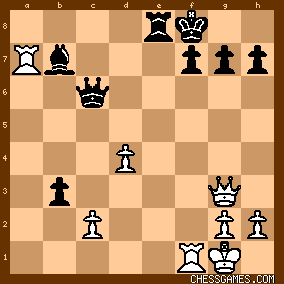
click for larger view22 ♖f1xf7+!
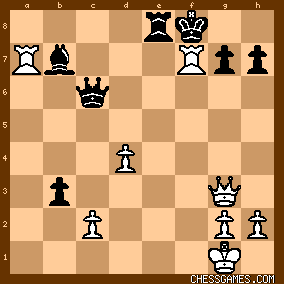
click for larger viewThe point of Rublevsky's excellent 22 ♖f1xf7+! is to <EXPOSE> the Black king with 22 ... ♔f8x♖f7 for the <DOUBLE ATTACK WITH CHECK> 23 ♕g3xb3+, where the White b3-queen spears the 1-1 <LOOSE> Black b7-bishop. 22 ... ♔f8x♖f7 23 ♕g3xb3+ <queen fork>

click for larger view |
|
| Feb-10-09 | | Ychromosome: Is there a technical name for white's pawn structure on move 14? |
|
| Feb-10-09 | | notyetagm: <Ychromosome: Is there a technical name for white's pawn structure on move 14?> 14 c3-c4
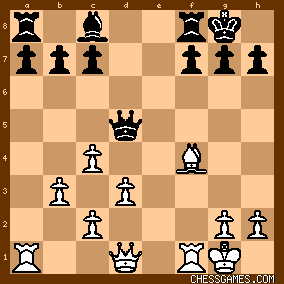
click for larger viewI would call that pawn structure a <PAWN DIAMOND>. |
|
| Feb-10-09 | | Gilmoy: Since it's four white pawns, it's a <Thunderbirds>. Up close, you see they're actually F-16 Fighting Falcons in USAF trim: http://en.wikipedia.org/wiki/File:U... With four black pawns, it's a <Blue Angels> at dusk :)
http://en.wikipedia.org/wiki/File:B... |
|
| Apr-25-09 | | WhiteRook48: 35 d7!!! |
|
| Jul-18-09 | | National Master Dale: 14.c4 ponnuki 30 points |
|
| Feb-28-17 | | saturn2: After the three moves Rxf7 followed by Qxb3 and R(Q)xBb7 white is up two pawns. Black can check Rf1+ then but it is not dangerous. |
|
| Feb-28-17 | | Skewbrow: Hmm. The forcing sequence 22. Rxf7 Kxg7, 23. Qxb3+ King move, 24. Rxb7 trades a rook for a bishop and two pawns. This A) eliminates black threats formed by the advanced pawn and the artillery along the main diagonal, and B) leaves white with two connected passed pawns (though mostly at the starting gate). Also, depending on where black moves the king, white still has at least one "free" move as black either needs to defend the mate threat at f7, or if the king came out, the pin along the sixth rank. Doesn't look like very Tuesdayish, but I couldn't find anything better. |
|
| Feb-28-17 | | Cheapo by the Dozen: What <Skewbrow> said. |
|
| Feb-28-17 | | dfcx: Excellent analysis by <notyetagm> more than 8 years ago... |
|
Feb-28-17
 | | radtop: Why doesn't 25. Qf3 win more quickly? |
|
| Feb-28-17 | | leRevenant: 15 moves for an easy Tuesday mate |
|
| Feb-28-17 | | YouRang: Tuesday 22.?

click for larger view
So, white is up the exchange, but white's Q must defend against ...Qxg2#. White also has two connected queenside pawns which would be passers, apart from black's annoying Pb3. In short, white is already better, but there are complications. In such a situations it feels good to simplify to a winning ending. One looks for a forcing move, and the obvious one is <22.Rxf7+ Kxf7>
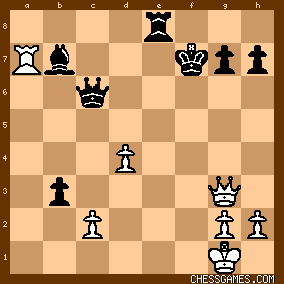
click for larger view
With this R-sac, we've forced black's K to step into a pin on Bb7, and we've exposed it on the a2-g8 diagonal. This makes it safe to take the pawn with check <23.Qxb3+>, which also puts a double attack on the pinned bishop.

click for larger view
After the king moves, white takes the bishop, e.g. <23...Kf8 24.Rxb7>, and now white's Q and R are working together, the annoying Pb3 is gone, and Pc2 is protected.

click for larger view
White should win handily with the advantage of two protected and connected passed pawns in a simplified ending, especially since black's K is so exposed. Here, I would expect 24...Qf6 (to prevent Qf7#) 25.Qb4+ (to prevent ...Re1#, with check) 25...Kg8, and then simplify further with 26.Rb8, forcing an exchange of rooks. Then I should think it's truly resignable for black. |
|
| Feb-28-17 | | agb2002: White has a rook for a bishop.
Black threatens bxc2.
The black pawns and bishop on b3, f7 and b7 suggest 22.Rxf7+ Kxf7 (22... Kg8 23.Qxg7#) 23.Qxb3+: A) 23... Qd5 24.Qxd5+ wins.
B) 23... Qe6 24.Rxb7+ followed by Qxe6 + - [2P]. C) 23... Re6 24.Qxb7+ as in B.
D) 23... Kf8 24.Rxb7
D.1) 24... Re1+ 25.Kf2 Re2+ 26.Kxe2 Qxg2+ 27.Kd3 and the king goes to b2, winning. D.2) 24... Qf6 25.Qf3 Qxf3 26.gxf3 + - [2P] with a won ending. For example, 26... Re1+ 27.Kf2 Rh1 28.Kg2 followed by the advance of the passed pawns. E) 23... Kf(g)6 24.Rxb7 + - [2P] and the threats Ra6 and Qf7+. |
|
| Feb-28-17 | | gofer: Hmmm, <22 cxb3> wins a pawn, so not a complete disaster. Our queen can't go walk about due to Qxg2#, so the only other question is
whether <"2P+B+keeping two connected passed pawns and losing a rook"> is better than <"keeping our two rooks and winning a pawn, but
creating 3 pawn isolani">... ...probably the latter is the way to go... <22 Rxf7+ Kxf7> <23 Qxb3+ ...>
23 ...Kg6
24 Rxb7 
Black is very weak on f7 and the king is very easy to attack via g3,
which actually means that black is very weak on f7 and g7! 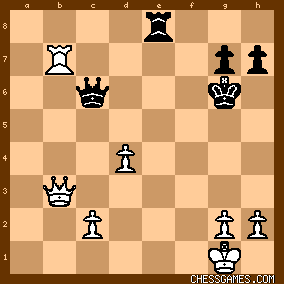
click for larger view<23 ... Kf8>
<24 Rxb7> 
White has what he wants; two connected passed pawns so how to use them best!?
9 moves later we reach here...

click for larger viewThe only question is... ...why can't black play <33 ... Qxc4>?! A nice little instructive puzzle - probably even <Tuesday> level!? |
|
| Feb-28-17 | | Once: There are multiple winning solutions today. White starts the position up by an exchange and a pawn and black doesn't really have all that many threats. The game continuation is the flashy way, but white also steers home the point with any one of 22. Qf3, 22. Qf2 and even the simple 22. axb3. And a few others besides. After a few minutes of thought, Fritzie scores it: 22. Rxf7+ (+2.67)
22. Qf3 (+2.12)
22. Qf2 (+1.68)
22. axb3 (+1.68)
Sure the pac-man material gobbling of 22. Rxf7+ is the best continuation, but it's only half a prawn over the far more sedate 22. Qf3 and 1 prawn over the rock solid 22. Qf2 or 22. axb3. There is one continuation which gives me a little pause for thought about 22. Rxf7+. After 22... Kxf7 23. Qxb3+ Kf8 24. Rxb7 we arrive here: 
click for larger viewWhite is two pawns up and is threatening mate on f7. But it's black to move and he has the chance to check the white king with 24... Re1+. So as white we've got to ask ourselves "are we frightened?" Does black have a mating or drawing threat against our king? Probably not, but it needs to be checked. Rewind back to the puzzle position. 22. Rxf7+ is the grandstanding continuation but we have to calculate the un-Tuesday-ish position after 24... Re1+. In puzzle mode, I found 22. Rxf7+ but it took me a while to be entirely sure about it. That didn't feel Tuesday-ish. In human mode in a real game and if the tock was clicking, I would probably have played 22...axb3 or 22...Qf2 followed by axb3. Seems safe enough to win and I don't give black the chance for any checks which may or may not be nasty. |
|
| Feb-28-17 | | The Kings Domain: Nice puzzle, tougher than the description. Good sacrifice by white that just laid his opponent bare. |
|
| Feb-28-17 | | sid299792: <gofer: Why can't Black play 33...Qxc4> most probably because of 34.Rf8+! which deflects the rook |
|
| Feb-28-17 | | zb2cr: Whites gives back the exchange to get to an ending where he's up by 2 connected passed Pawns. |
|
| Feb-28-17 | | Carlos0012358: Looks like 24.Rxb7 would have been better. It leads to exchanging Rooks and Queens and an end game of Kings and 4 vs 2 pawns. |
|
| Feb-28-17 | | Moszkowski012273: 26.Rb8... is quite good enough. |
|
| Feb-28-17 | | ChessHigherCat: I would have forced the trade of Queens with 25. Qf3 and white wins easily, I don't know why he wanted to enter into complications |
|
| Feb-28-17 | | morfishine: Since multiple moves win, the challenge is to find the most solutions; I count 5 ***** |
|
| Feb-28-17 | | BOSTER: 18...Re2 was much better. |
|
 |
|
< Earlier Kibitzing · PAGE 1 OF 2 ·
Later Kibitzing> |





